Welcome to a exploration of the Polyamorous Flag, a captivating emblem that transcends fabric to symbolize the rich tapestry of openness, love, and support within the dynamic realm of polyamorous relationships. Join us as we delve into the colors, beauty, and profound symbolism that define this flag, celebrating the diverse and inclusive nature of love in all its forms.

Download the Polyamorous Flag as a HR PNG or SVG.
Meaning and Symbolism
The Polyamorous Flag is more than just a vibrant array of colors; it serves as a powerful symbol for the diverse and inclusive nature of polyamorous relationships. As a beacon for the polyamorous community, this flag proudly waves, representing the values and principles embraced by those who practice non-monogamous and open relationships.
Let’s break down the Polyamorous Flag colors, each holding its own significance within the community. The flag consists of three horizontal stripes – blue, red, and black. Blue, situated at the top, symbolizes openness and honesty among partners. It reflects the transparency crucial to the foundation of polyamorous relationships. Red, in the middle, represents love and passion, acknowledging the multiple romantic connections that individuals may form. Finally, black, at the bottom, embodies solidarity and support within the polyamorous community, emphasizing the strength found in shared experiences.
Polyamory, as a lifestyle, celebrates relationship diversity and challenges traditional notions of monogamy. The Polyamorous Flag stands as a testament to this diversity, offering a visual representation that fosters inclusivity and unity among those who identify with or support polyamorous relationships.
In addition to its symbolic role, the Polyamorous Flag plays a crucial part in raising awareness about polyamory. It serves as a recognizable symbol at events and gatherings, creating a sense of belonging for individuals in the polyamorous community. The flag acts as a rallying point for the LGBTQ+ community, as polyamorous relationships intersect with various sexual orientations and gender identities, contributing to a broader spectrum of inclusive relationship flags.
Whether fluttering at polyamorous events or adorning various resources and support materials, the Polyamorous Flag stands tall, providing visibility and representation for a lifestyle that embraces love in its many forms.

History of the Polyamorous Flag
The Polyamorous Flag, with its distinctive colors and meaningful symbolism, has a rich history that reflects the journey of the polyamorous community. Designed to represent the values and principles of individuals in non-monogamous relationships, the flag’s origin can be traced back to the early 1995.
Created by Jim Evans, also known as “Jim Duvall,” the Polyamorous Flag made its debut in 2013 at the Atlanta Poly Weekend, an annual event dedicated to fostering awareness and support for polyamorous relationships. Evans, a graphic designer and polyamory advocate, crafted the flag with the intention of providing a visible symbol for the growing polyamorous community.
The flag’s design consists of three horizontal stripes: blue at the top, red in the middle, and black at the bottom. These colors were carefully chosen to encapsulate the core tenets of polyamory. Blue signifies openness and honesty, red represents love and passion, while black embodies solidarity and support within the community.
Since its introduction, the Polyamorous Flag has become an integral part of the polyamorous movement, gaining recognition and acceptance on a global scale. The flag is proudly displayed at polyamorous events, gatherings, and on various online platforms, symbolizing a sense of unity and belonging among those who identify with or support polyamorous relationships.
The history of the Polyamorous Flag is a testament to the resilience and visibility of the polyamorous community. As the flag continues to be a powerful symbol, it not only represents the diverse relationships within the polyamorous lifestyle but also stands as a beacon for inclusivity and acceptance in a society that is increasingly embracing relationship diversity.

Colors and Their Representation
- Blue: The blue stripe at the top of the Polyamorous Flag symbolizes openness and honesty within polyamorous relationships. It serves as a visual reminder of the transparency that is foundational to the communication and trust required in maintaining multiple romantic connections.
- Red: Positioned in the middle, the red stripe represents love and passion. This color signifies the varied romantic attachments that individuals in polyamorous relationships may form. It is a vibrant reminder of the emotional richness and depth inherent in the polyamorous lifestyle.
- Black: The black stripe at the bottom of the flag embodies solidarity and support within the polyamorous community. This color represents the strength found in shared experiences and the mutual encouragement that individuals in non-monogamous relationships provide to one another. It signifies a united front in the face of societal norms and challenges.
These three distinct colors work in harmony to create the Polyamorous Flag, a visual expression of the values and principles embraced by the polyamorous community. The deliberate choice of each color reflects the intention to convey openness, love, and support, fostering a sense of identity and belonging among individuals who practice or advocate for polyamorous relationships. Whether at events or within the digital landscape, the Polyamorous Flag’s colors serve as a recognizable and unifying symbol, representing the diversity and inclusivity inherent in the polyamorous lifestyle.

What are the RAL or Pantone colors of the Polyamorous flag?
The Polyamorous flag doesn’t have official Pantone or RAL specifications, the following approximations can be used:

BLUE
Pantone: 2726 C
RAL: 5002
HEX: #0000ff

RED
Pantone: 185 C
RAL: 3024
HEX: #ff0000

BLACK
Pantone: Black C
RAL: 9005
HEX: #000000

YELLOW PI Symbol
Pantone: Yellow 012 C
RAL: 1023
HEX: #ffff00
Kindly be aware that the colors mentioned here are approximations, and the exact shades may vary based on factors such as the production method, material, and lighting conditions. For accurate color representation, it is advisable to utilize physical color samples or seek guidance from a professional color matching service.

Usage and Recognition
- Visibility at Events: The Polyamorous Flag has gained widespread recognition as a prominent symbol at polyamorous events and gatherings. Whether fluttering in the breeze at conferences, workshops, or pride parades, the flag serves as a visual representation of the polyamorous community, fostering a sense of unity among attendees.
- Online Platforms: In the digital realm, the Polyamorous Flag has found a virtual home on various online platforms. Social media, forums, and dating apps that cater to the polyamorous community often feature the flag prominently, creating a sense of visibility and solidarity for individuals exploring or actively participating in non-monogamous relationships.
- Resources and Support Materials: The flag is not limited to being a visual marker; it plays a crucial role in printed materials and resources related to polyamory. From informational pamphlets to support group materials, the flag’s presence helps create a recognizable and inclusive representation for those seeking information, guidance, or a sense of community.
- Global Recognition: Over the years, the Polyamorous Flag has transcended geographical boundaries, gaining recognition on a global scale. Its distinctive colors and design have become synonymous with the polyamorous lifestyle, offering a shared symbol that resonates with individuals worldwide. This recognition contributes to a sense of belonging for those in the polyamorous community, regardless of their location.
- Inclusivity in LGBTQ+ Representation: The Polyamorous Flag often stands alongside other LGBTQ+ flags, emphasizing the intersectionality between polyamorous relationships and diverse sexual orientations and gender identities. Its presence in LGBTQ+ spaces reinforces the inclusive nature of the polyamorous lifestyle within the broader spectrum of relationships and sexualities.
In summary, the Polyamorous Flag’s usage and recognition extend beyond its physical form. It is a dynamic symbol that has found its place both in physical spaces and online communities, offering visibility, representation, and a shared identity for those navigating the diverse landscape of polyamorous relationships.
Related Flags and Symbols:

Rainbow Flag: The universally recognized LGBTQ+ Pride flag, featuring a spectrum of colors, designed by Gilbert Baker.

Transgender Pride Flag: Designed by transgender activist and Navy veteran Monica Helms, it consists of light blue, pink, and white stripes, representing the transgender community.
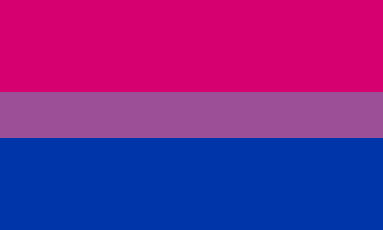
Bisexual Pride Flag: Created by Michael Page, it features three horizontal stripes—pink, purple, and blue—symbolizing attraction to more than one gender.

Pansexual Pride Flag: Designed by various activists, it consists of three horizontal stripes—pink, yellow, and blue—representing attraction regardless of gender.

Non-Binary Pride Flag: Created by Kye Rowan, it features yellow, white, purple, and black stripes, symbolizing genders outside the traditional binary.

Genderqueer Pride Flag: Designed by Marilyn Roxie, it features lavender, white, and dark green stripes, representing genderqueer, non-binary, and genderfluid identities.
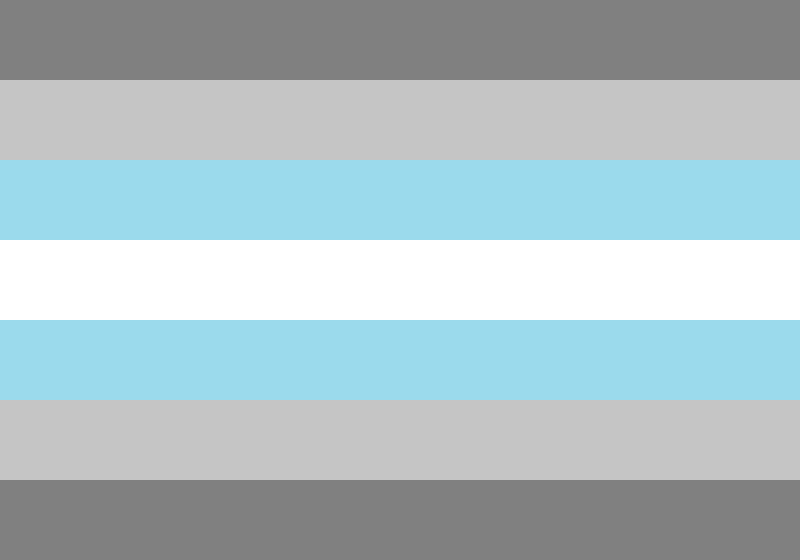
Demiboy Pride Flag: Designed by an anonymous Tumblr user, it consists of light blue, white, and black stripes, representing a partial connection to being male.

Demigirl Pride Flag: Also designed by an anonymous Tumblr user, it features light pink, white, and black stripes, representing a partial connection to being female.
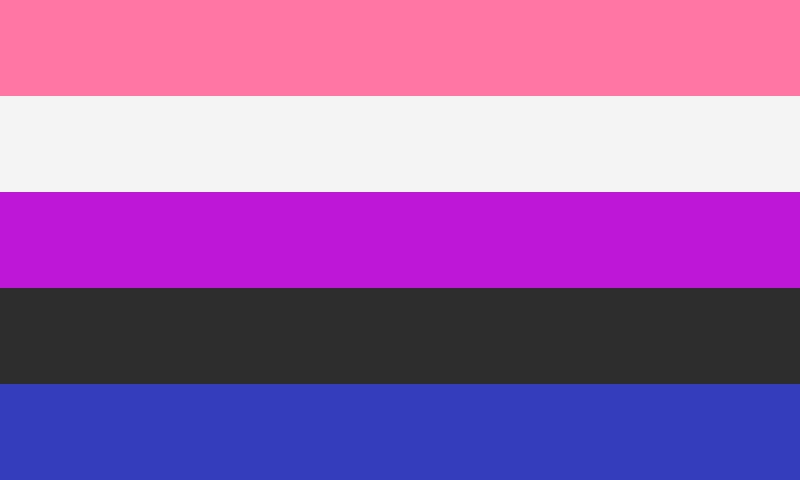
The Genderfluid Flag: designed in 2012 by activist JJ Poole, is a vibrant emblem symbolizing the diverse spectrum of gender identities, with each carefully chosen color representing different facets of the genderfluid experience.

The Omnisexual Flag: Omnisexuality involves attraction to all genders, with preferences varying. Created in 2015, the Omnisexual Pride Flag represents the gender spectrum with light pink and blue for femininity and masculinity, and dark purple for those outside traditional categories..
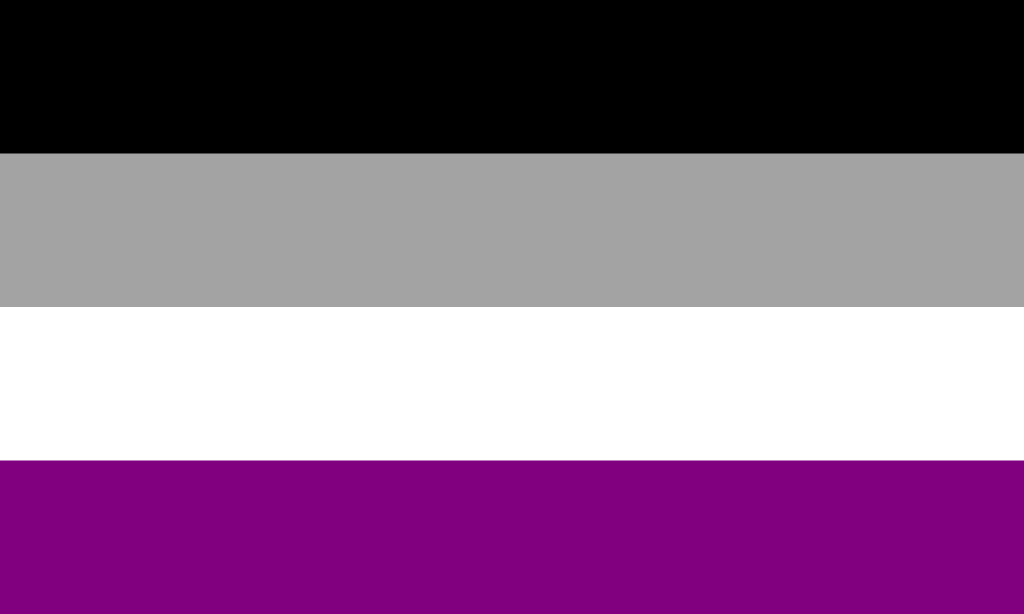
The Asexual Pride Flag:
Crafted in 2010 by StandUp of AVEN, the Asexual Pride Flag symbolizes the asexual community with its four horizontal stripes: black for asexuality, gray for the spectrum, white for sexuality, and purple for diversity. Read more.
Polyamorous Community Acceptance and Adoption
- Growing Acceptance: The Polyamorous Flag has played a pivotal role in fostering acceptance within the polyamorous community itself. As the flag became more widely recognized, it acted as a unifying symbol for individuals practicing or exploring polyamory, creating a shared visual identity. This sense of belonging has contributed to the overall acceptance of diverse relationship structures within the community.
- Symbol of Pride: The adoption of the Polyamorous Flag as a symbol of pride is evident in the community’s events and social spaces. Its presence at gatherings signifies not only visibility but also a collective acknowledgment and celebration of the polyamorous lifestyle. The flag serves as a reminder that individuals can embrace and express their relationship choices with pride and without judgment.
- Facilitating Conversations: The Polyamorous Flag has become a conversation starter within the community. Its recognizable design prompts discussions about the values it represents, such as openness, love, and support. This has facilitated a deeper understanding of the varied dynamics within polyamorous relationships and has encouraged open dialogues about consent, communication, and relationship diversity.
- Encouraging Representation: The flag’s adoption has encouraged representation within the broader LGBTQ+ community. As polyamorous relationships intersect with various sexual orientations and gender identities, the flag stands as a symbol of inclusivity. Its presence alongside other LGBTQ+ flags reinforces the acceptance of diverse relationship structures within the larger context of the queer community.
- Championing Diversity: The Polyamorous Flag serves as a beacon for relationship diversity, challenging societal norms and promoting the acceptance of non-traditional relationship structures. Its adoption reflects a collective effort within the polyamorous community to create an inclusive space that embraces the myriad ways individuals can experience and express love.
In essence, the acceptance and adoption of the Polyamorous Flag within the polyamorous community have played a crucial role in building solidarity, fostering pride, and promoting understanding. As a symbol of shared values, it continues to contribute to the evolving narrative of acceptance and recognition for individuals navigating the multifaceted landscape of polyamorous relationships.

What does it mean to be Polyamorous?
Polyamory, at its core, is a relationship orientation that challenges the traditional norms of monogamy. The term “polyamory” is derived from Greek, with “poly” meaning many and “amor” meaning love, encapsulating the essence of this lifestyle – the capacity and willingness to love and form romantic connections with multiple partners simultaneously.
Being polyamorous involves cultivating consensual, ethical, and transparent relationships that go beyond the confines of exclusivity. Key aspects of polyamorous relationships include open communication, honesty, and a commitment to respecting the autonomy and well-being of all involved parties.
In polyamorous dynamics, individuals may have multiple romantic or sexual relationships, each with its own unique dynamics and boundaries. These relationships can take various forms, including hierarchical structures with primary and secondary partners or non-hierarchical arrangements where all partners hold equal importance.
Crucial to the philosophy of polyamory is the recognition that love and connection are not finite resources. Instead of adhering to the belief that one person must fulfill all emotional and romantic needs, polyamorous individuals embrace the idea that multiple fulfilling connections can coexist.
It’s important to note that polyamory is not synonymous with promiscuity or a lack of commitment. Rather, it involves intentional, consensual choices to explore and nurture meaningful connections with the understanding and consent of all parties involved.
In essence, being polyamorous means rejecting the societal expectation of exclusive monogamy in favor of a more expansive and inclusive approach to love and relationships. It requires self-awareness, effective communication skills, and a commitment to ethical and consensual practices, ultimately allowing individuals to navigate the complex landscape of multiple, loving connections.

What are the different types of Polyamorous people?
Polyamory is a diverse and inclusive relationship orientation that comes in various forms, reflecting the unique preferences, needs, and agreements of individuals and their partners. Here are some common types of polyamorous relationships:
- Hierarchical Polyamory: In hierarchical polyamory, individuals may designate certain partners as primary, secondary, or tertiary, creating a structured hierarchy. Each level may have different levels of commitment, time, and emotional investment.
- Non-Hierarchical Polyamory: In contrast, non-hierarchical polyamory rejects structured hierarchies, emphasizing that all relationships are of equal importance. This approach aims to foster a sense of equality and minimize the potential for power imbalances.
- Solo Polyamory: Solo polyamory involves individuals who prefer to maintain their autonomy and independence while engaging in multiple romantic relationships. These individuals may not seek a primary partner or prioritize solo adventures and self-discovery.
- Kitchen Table Polyamory: Kitchen table polyamory describes a dynamic where all partners feel comfortable sitting around the metaphorical “kitchen table” together. This type of polyamory emphasizes open communication and a sense of extended family, with partners often interacting and building connections.
- Parallel Polyamory: Parallel polyamory refers to individuals who maintain separate, distinct relationships without extensive overlap between their partners. Each connection exists independently, and partners may not have direct interaction with one another.
- Polyfidelity: Polyfidelity involves a group of individuals who are exclusively committed to each other. It functions similarly to monogamy but within a group setting, where all members agree to be exclusive within the defined polyfidelitous circle.
- Swinging: While not exclusively polyamorous, some polyamorous individuals participate in swinging, which involves engaging in consensual, non-monogamous sexual activities with others. Swinging focuses primarily on recreational sex rather than forming romantic connections.
- Polyamorous Families: Polyamorous families can include parents with multiple partners who collectively share parenting responsibilities. These families often prioritize open communication, transparency, and a collaborative approach to childcare.
It’s essential to recognize that these categories are not rigid, and individuals may combine elements from different types to create relationships that suit their unique preferences and circumstances. The key to successful polyamorous relationships lies in open communication, consent, and a commitment to understanding and respecting the needs and boundaries of all parties involved.

Inclusivity and Representation
Polyamory, as a relationship orientation, thrives on inclusivity and representation, acknowledging the diversity of individuals and their unique experiences within non-monogamous dynamics. Here’s a glimpse into how inclusivity and representation manifest in the polyamorous community:
- LGBTQ+ Inclusivity: Polyamorous communities actively embrace individuals across the LGBTQ+ spectrum. The intersectionality between polyamory and diverse sexual orientations and gender identities is celebrated, fostering an inclusive environment where everyone can authentically express their love and identity.
- Cultural and Ethnic Diversity: In the spirit of inclusivity, polyamorous communities recognize and celebrate cultural and ethnic diversity. This acknowledgment allows for a rich tapestry of perspectives, traditions, and values within the community, ensuring that polyamorous relationships are seen through various cultural lenses.
- Relationship Configurations: Representation extends to the various relationship configurations that exist within polyamory. Whether individuals practice hierarchical or non-hierarchical polyamory, solo polyamory, or engage in diverse family structures, the polyamorous community acknowledges and values the multitude of ways people navigate their relationships.
- Disability and Neurodiversity: The polyamorous community is increasingly recognizing and accommodating the unique needs of individuals with disabilities and those who are neurodivergent. Efforts are made to create accessible spaces and resources, ensuring that everyone, regardless of ability or neurodivergence, feels welcome and understood.
- Age and Relationship Stage Diversity: Inclusivity in polyamory spans across age groups and relationship stages. Whether individuals are exploring polyamory for the first time, practicing it in their middle years, or navigating it in later life, the community values the wisdom and experiences that individuals from various life stages bring to the conversation.
- Polyamorous Families and Parenting: Representation in polyamory extends to families and parenting structures. Acknowledging that polyamorous individuals may form families with multiple parents, the community supports inclusive parenting narratives and resources that cater to the unique dynamics of polyamorous families.
- Visibility in Media and Literature: Efforts are being made to increase representation of polyamorous relationships in mainstream media and literature. This includes accurate and positive portrayals that reflect the diversity of polyamorous experiences, helping to break down stereotypes and promote understanding.
In essence, the polyamorous community actively strives to be inclusive and representative of the rich tapestry of human experiences. By recognizing and celebrating diverse identities, relationships, and perspectives, polyamory continues to evolve as a space where individuals can authentically express their love and connect with others who share similar values.
Support and Resources
In the ever-expanding landscape of polyamorous relationships, having access to support and resources is crucial for individuals seeking guidance, understanding, and connection. Here’s a glimpse into the wealth of support and resources available within the polyamorous community:
- Online Communities and Forums: Virtual spaces play a pivotal role in connecting polyamorous individuals worldwide. Online forums, social media groups, and dedicated websites provide platforms for sharing experiences, asking questions, and seeking advice. These spaces foster a sense of community and offer valuable insights from individuals with diverse polyamorous lifestyles.
- Books and Literature: A growing body of literature explores the intricacies of polyamorous relationships. From guidebooks to memoirs, these resources cover a range of topics, including communication strategies, navigating jealousy, and understanding different polyamorous dynamics. Accessible both online and in print, these resources serve as valuable companions on the polyamorous journey.
- Therapy and Counseling Services: Recognizing the unique challenges that can arise in polyamorous relationships, therapists and counselors with expertise in non-monogamy offer support tailored to the specific needs of individuals and polyamorous groups. These professionals provide a confidential space for exploring emotions, improving communication, and navigating relationship dynamics.
- Workshops and Events: Polyamorous events and workshops offer opportunities for individuals to learn, connect, and engage with others in the community. From local meet-ups to international conferences, these events provide a supportive environment for sharing experiences, gaining insights, and building a network of like-minded individuals.
- Online Courses and Webinars: Educational platforms and online courses specifically focused on polyamory provide accessible learning opportunities. These resources cover a range of topics, from relationship skills to navigating ethical non-monogamy, offering a structured approach for those seeking more in-depth knowledge.
- Support Groups: Local and online support groups cater to individuals who benefit from a more intimate and personal setting. These groups often facilitate discussions on various aspects of polyamory, allowing participants to share experiences, seek advice, and build connections within their local or online communities.
- Legal and Financial Guidance: Recognizing the unique legal and financial considerations in polyamorous relationships, some resources provide guidance on topics such as estate planning, co-parenting agreements, and navigating legal frameworks. These resources aim to empower individuals to make informed decisions regarding the legal aspects of their relationships.
- Podcasts and Media: Polyamorous-themed podcasts and media offer a dynamic and engaging way to access information and stories. These platforms cover a wide range of topics, providing a mix of expert advice, personal narratives, and discussions on various aspects of polyamorous living.
Where to buy a Polyamorous Flag?
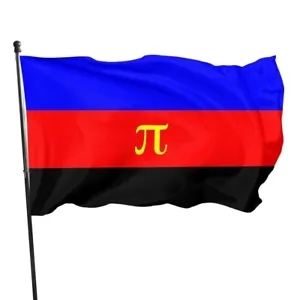
Buy pride flags on Ebay
Ebay has a large collection of HQ and affordable Polyamorous Flags!
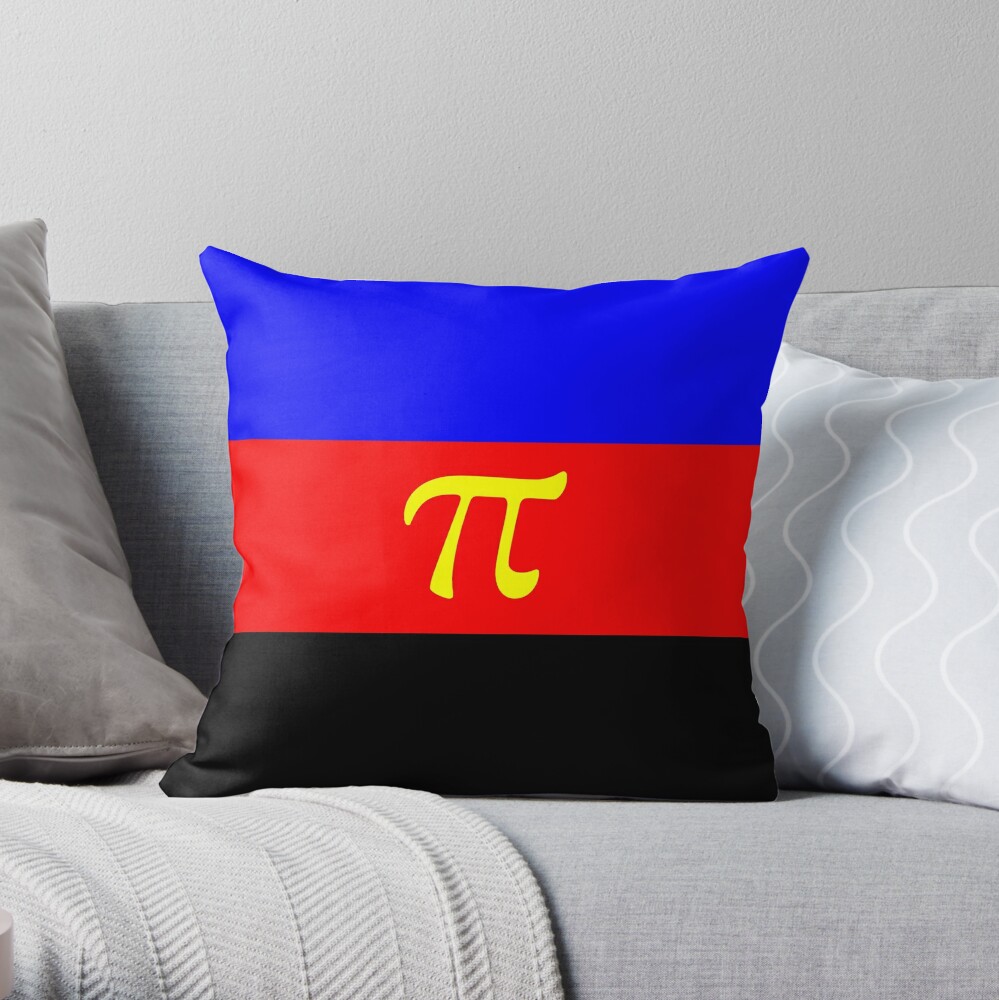
Buy products on Redbubble
Redbubble has a large collection of products with the Polyamorous Flag, such as pillows, phone cases, T-shirts, mugs, hats, and much more!
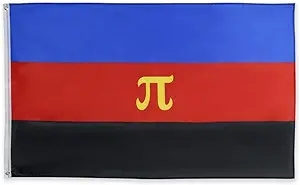
Buy on Amazon
Amazon has lots of Polyamorous Flags!

Download the Polyamorous Flag.
Download as (8500×5700 px) PNG or SVG.
Can I use the downloaded flag for my personal projects? Yes you can, this flag is in the public domain and you can use it whatever way you like.
How about commercial? The same, you can use it commercially and personally!
How do I know I am Polyamorous?
Determining if you are polyamorous involves a process of self-reflection and an exploration of your feelings, desires, and relationship preferences. Here are some signs and considerations that may indicate a polyamorous orientation:
- Desire for Multiple Connections: If you find yourself naturally drawn to the idea of forming romantic or intimate connections with more than one person simultaneously and feel a sense of fulfillment in doing so, this could be an indication of a polyamorous inclination.
- Embracing Relationship Diversity: Polyamory is often characterized by an openness to diverse relationship structures. If you appreciate the idea of relationships that go beyond traditional monogamy and believe in the possibility of maintaining multiple meaningful connections, you may align with a polyamorous mindset.
- Communication and Transparency: Polyamorous relationships thrive on open communication and transparency. If you value discussing emotions, needs, and boundaries openly with your partners and are comfortable with the idea of sharing these details among multiple individuals, you might have a predisposition toward polyamory.
- Managing Jealousy: Successful polyamorous relationships often involve effective communication about emotions, including jealousy. If you find that you can navigate and address feelings of jealousy in a constructive manner, it may indicate a level of emotional resilience conducive to polyamorous dynamics.
- Independence and Autonomy: Individuals who are comfortable with maintaining their independence within relationships and appreciate the autonomy of their partners may resonate with the principles of polyamory, which often emphasize personal freedom and self-expression.
- Interest in Polyamorous Literature and Media: If you find yourself drawn to literature, podcasts, or media that explore polyamorous themes and lifestyles and feel a resonance with the narratives presented, it could be a sign that polyamory aligns with your relationship values.
- Reflection on Past Relationships: Consider reflecting on past relationships and whether you’ve ever felt restricted by monogamous norms. If you’ve experienced a sense of unfulfilled desire for multiple connections or felt that traditional relationship structures didn’t fully capture your needs, it may point toward a polyamorous orientation.
- Curiosity and Openness: Polyamory often involves a curiosity about exploring various aspects of relationships. If you’re open to learning about and understanding different relationship dynamics, and you feel a genuine interest in embracing diverse forms of love and connection, this may be an indication of a polyamorous mindset.
It’s important to note that self-discovery is a personal journey, and there is no one-size-fits-all definition of polyamory. Reflecting on your feelings, experiences, and values, and being open to the possibility of different relationship structures, can guide you in understanding whether polyamory aligns with your authentic self. If you find these signs resonating with your experiences, it may be worthwhile to explore polyamory further and engage in open communication with potential partners about your relationship preferences.
Recommended books
There are several books that explore and address the experiences of Polyamorous individuals, offering insights, narratives, and perspectives that can be both validating and enlightening. Here are some recommendations:
- “Stone Butch Blues” by Leslie Feinberg
This novel is a classic in LGBTQ literature and follows the life of a gender-nonconforming protagonist, exploring themes of identity and resilience.
- “Nevada” by Imogen Binnie
This novel centers around a transgender protagonist and delves into themes of self-discovery, identity, and the challenges of navigating a genderqueer existence.
- “Gender Outlaws: The Next Generation” edited by Kate Bornstein and S. Bear Bergman
This anthology features diverse voices within the LGBTQ community, including essays and narratives that encompass a wide range of gender identities and expressions. - “Genderqueer: Voices Beyond the Sexual Binary” edited by Joan Nestle, Clare Howell, and Riki Wilchins
This collection brings together personal narratives, essays, and poems that explore the experiences of genderqueer individuals, providing a rich and varied perspective. - “They/Them/Their: A Guide to Nonbinary and Genderqueer Identities” by Eris Young
A comprehensive guide that explores nonbinary and genderqueer identities, offering insights and information for those seeking to understand or navigate these experiences. - “Trans Bodies, Trans Selves” edited by Laura Erickson-Schroth
This resource covers a wide range of topics related to transgender and gender-nonconforming experiences, offering practical information and personal narratives. - “The ABC’s of LGBT+” by Ashley Mardell
Geared towards a younger audience, this book provides an accessible and informative guide to various aspects of the LGBTQ+ spectrum, including Omnisexuality. - “Trans Like Me: Conversations for All of Us” by C.N. Lester
C.N. Lester, a nonbinary activist, explores the complexities of gender identity in this thought-provoking book, combining personal experiences with broader discussions about gender. - “The Art of Being Normal” by Lisa Williamson
A fictional narrative that follows the lives of two transgender teens, this novel provides a relatable and engaging story that can resonate with individuals exploring their own identities. - “Beyond Magenta: Transgender Teens Speak Out” by Susan Kuklin
This book shares the stories of transgender and genderqueer teens, providing a platform for their voices and experiences.
These books cover a range of genres and styles, offering Polyamorous individuals and those seeking to understand more about gender diversity a diverse and enriching reading list. It’s essential to explore various perspectives to gain a more comprehensive understanding of the fluidity and diversity within gender identities.

Educational content and resources:
Explore the following collection of resources and websites tailored to provide valuable support and information for individuals navigating Polyamorous identities. Whether you are seeking community connections, educational materials, or assistance in understanding and expressing your gender identity, these platforms have been curated to offer a diverse range of perspectives and resources.
- Nonbinary.org
- Offers a wealth of information on nonbinary and genderqueer identities.
- GLAAD‘s Tips for Allies of Transgender People
- Provides guidance for allies of transgender and gender nonconforming individuals.
- Gender Diversity
- Offers resources and support for families and children exploring gender identity.
- National Center for Transgender Equality (NCTE)
- Advocacy organization working towards policy reform and transgender equality.
- The Trevor Project
- A crisis intervention and suicide prevention organization for LGBTQ+ youth.
- Transgender Equality
- Provides resources, policy advocacy, and educational materials.
- Genderqueer.me
- A resource hub with articles, stories, and information on genderqueer identities.
- Autostraddle’s “Queer Your Tech”
- A tech and culture column that often includes gender-related content.
- Trans Lifeline
- A crisis hotline and resource for transgender individuals.
- PFLAG
- Offers support and resources for LGBTQ+ individuals, their families, and allies.
- Gender Diversity: Beyond the Binary
- A TED Talk playlist featuring discussions on gender diversity.
- Human Rights Campaign (HRC)
- Advocacy and educational resources for LGBTQ+ rights.
- Pronouns.org
- Offers guidance on using and respecting personal pronouns.
- National LGBTQ Task Force
- Advocacy organization working towards justice and equality for LGBTQ+ individuals.
- The Agender Project
- A platform for sharing experiences and resources related to agender identities.
- The Queer Encyclopedia
- A comprehensive resource with entries on a wide range of LGBTQ+ topics.
- Astraea Lesbian Foundation for Justice
- A foundation supporting LGBTQ+ rights globally, including gender-related issues.
Conclusion

The Polyamorous Flag is a vibrant symbol representing the values of openness, love, and solidarity within the polyamorous community. Designed by Jim Evans in 1995, the flag features three horizontal stripes – blue for transparency, red for love, and black for support. It serves as a visible and unifying emblem at events, online platforms, and resources, fostering awareness, representation, and a sense of belonging among individuals embracing non-monogamous and open relationships.
The flag’s distinctive colors and design have become synonymous with the diverse and inclusive nature of polyamorous lifestyles, making it a powerful and recognizable symbol worldwide.

FAQs and Common Misconceptions

What does each color on the Polyamorous Flag represent?
The blue stripe symbolizes openness and honesty, red represents love and passion, and black embodies solidarity and support within polyamorous relationships.
Who designed the Polyamorous Flag, and when was it created?
Designed by Jim Evans, also known as “Jim Duvall,” the Polyamorous Flag made its debut in 2013 at the Atlanta Poly Weekend.
How is the Polyamorous Flag used within the LGBTQ+ community?
The Polyamorous Flag is often displayed alongside other LGBTQ+ flags, emphasizing the intersectionality between polyamorous relationships and diverse sexual orientations and gender identities.
Are there other related flags and symbols within the LGBTQ+ community?
Yes, there are various flags representing different identities, including the Pansexual Flag, Genderqueer Flag, and Bisexual Flag, among others.
Can I create my own DIY version of the Polyamorous Flag?
Absolutely! DIY versions of the Polyamorous Flag are encouraged, fostering individual expression and creativity within the polyamorous community.
What is an example of Polyamorous?
An example of polyamorous relationships could include an individual openly and ethically engaging in romantic connections with multiple consenting partners, maintaining transparency and communication.
How has the Polyamorous Flag contributed to community acceptance and adoption?
The Polyamorous Flag has served as a unifying symbol, fostering acceptance and pride within the polyamorous community, creating visibility at events, and facilitating open conversations about diverse relationship structures.
How can the Polyamorous Flag contribute to promoting equality and understanding?
By representing openness, love, and support, the Polyamorous Flag promotes understanding of relationship diversity, challenging societal norms and contributing to a more inclusive perspective on love and connections.

Are there support networks and resources available for individuals exploring their gender identity?
Yes, numerous support networks and resources exist for individuals exploring their gender identity, offering guidance, community, and education, including online forums, counseling services, and educational materials.
What are the different types of Polyamorous people?
Polyamorous individuals can have diverse relationship styles, including hierarchical or non-hierarchical polyamory, solo polyamory, kitchen table polyamory, and swinging, each reflecting unique preferences and dynamics.
What is the Polyamorous Flag?
The Polyamorous Flag is a symbol representing the values of openness, love, and support within the polyamorous community. Designed by Jim Evans in 2013, it features three horizontal stripes of blue, red, and black, symbolizing transparency, passion, and solidarity, respectively.

What does the Polyamorous Flag mean?
The Polyamorous Flag represents the values of transparency, love, and support within the polyamorous community. Its colors – blue, red, and black – symbolize openness, passion, and solidarity, respectively.
What is the role of intersectionality in the LGBT and Polyamorous communities?
Intersectionality is pivotal in recognizing the diverse identities within the LGBT and Polyamorous communities, understanding that individuals may navigate various aspects of their identity simultaneously. It emphasizes the interconnected nature of factors such as sexual orientation, gender, and relationship structure.
By embracing intersectionality, these communities can work towards creating environments that respect and address the unique challenges faced by individuals with intersecting identities in both sexual orientation and relationship dynamics.
Are there specific pronouns I should use when referring to a Polyamorous person?
No, pronouns for polyamorous individuals are not predetermined. Use the pronouns that each individual prefers, respecting their gender identity and expression.
How does one come out as Polyamorous?
Coming out as polyamorous involves open and honest communication with trusted individuals. Sharing your feelings, experiences, and relationship preferences can help foster understanding and acceptance.
How can I be a supportive ally to someone who is LGBT or Polyamorous?
Being a supportive ally involves listening, educating yourself, respecting identities and pronouns, and standing up against discrimination. It’s crucial to offer understanding and empathy while recognizing and challenging biases.
Is being transgender the same as being Polyamorous?
No, being transgender and polyamorous are distinct aspects of identity. Transgender relates to gender identity, while polyamorous relates to relationship orientation. Individuals can be both transgender and polyamorous, but the two terms refer to different aspects of a person’s identity.
What is the difference between Polyamorous and non binary?
Polyamorous refers to a relationship orientation involving multiple romantic connections, while non-binary refers to a gender identity outside the traditional binary of male or female. These terms pertain to different aspects of identity.
How to tell if i am Polyamorous or Nonbinary?
Self-reflection and exploration are key. If you find fulfillment in multiple romantic connections, you might lean towards polyamory. For nonbinary identity, if you feel your gender identity doesn’t align strictly with male or female, you might be nonbinary.
What is the difference between Polyamorous and genderfluid?
Polyamorous relates to relationship orientation, involving multiple romantic connections, while genderfluid pertains to a gender identity that may shift over time. These terms refer to different aspects of identity.
Is polysexual and polyamorous the same?
No, they are distinct terms. Polysexual refers to a sexual orientation involving attraction to multiple genders but not necessarily simultaneous romantic relationships. Polyamorous, on the other hand, involves engaging in multiple romantic connections simultaneously.
Why does the Polyamorous Flag include a yellow Greek letter pi symbol?
The yellow Greek letter pi (π) in the center of the Polyamorous Flag holds symbolic significance. It is not specifically the mathematical symbol for pi but rather a representation of the first letter in the word “polyamory.” The use of this symbol aims to visually and linguistically tie the flag to the concept of polyamory.


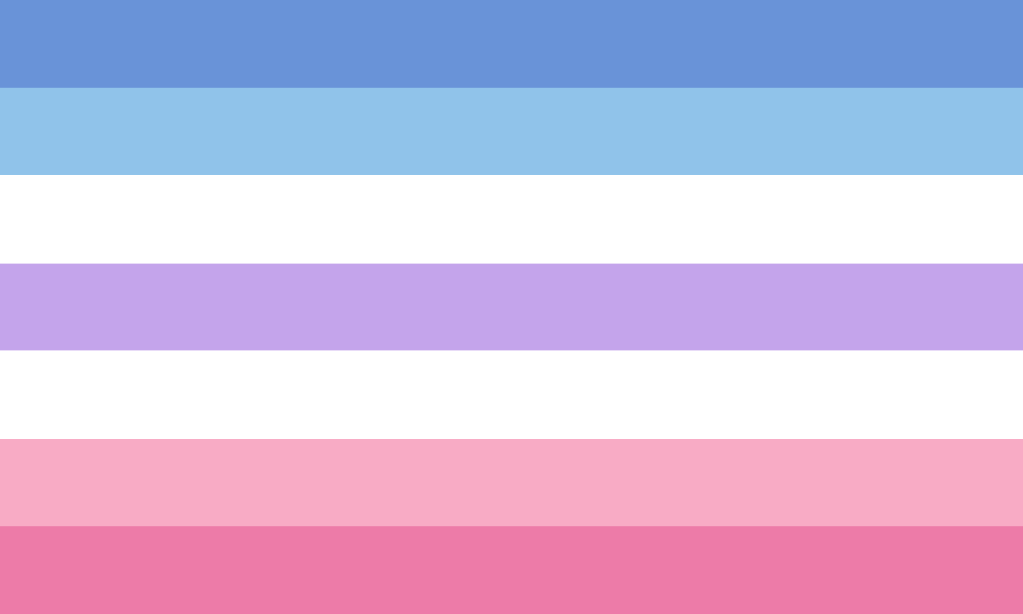


Leave a comment